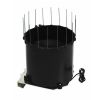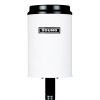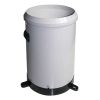Solinst Rainlogger 5 Rain Gauge Data Logger
The Solinst Rainlogger 5 is an inexpensive datalogger designed to record the tips of a standard tipping bucket rain gauge with a reed switch output.
Features
- Single-eye optical interface that is easy to clean and more scratch-resistant
- Increased memory: 150,000 sets of data
- Double o-ring seals for increased leakage protection
- Free ground shipping
- Expedited repair and warranty service
- Lifetime technical support
- More
Overview
The Rainlogger 5 is an inexpensive datalogger designed to record the tips of a standard tipping-bucket rain gauge. This compact and durable field unit offers long-term reliability and convenience with a battery that lasts up to 10 years and ESD (electrostatic discharge) protection with an ABS housing. The event timestamp and total rainfall per period is logged in non-volatile memory, which holds up to 100,000 readings. Sampling is event-based, as the Rainlogger 5 records and saves each tip of the tipping bucket as it happens.
Intuitive Levelogger Software
Levelogger customers can add rainfall data to their water level monitoring networks using the intuitive Levelogger Software. The Rainlogger 5 provides easy incorporation of precipitation data into existing Levelogger data. Rainfall data can correlate precipitation events and changes in groundwater or surface water levels. The Rainlogger 5 is compatible with all Solinst Levelogger 5 communication and deployment accessories. Logged data can be downloaded directly to a PC, using the Solinst Levelogger App, or a DataGrabber 5 data transfer device.
Interactive
The Rainlogger 5 is simply programmed with the user-friendly Levelogger Software. A Field Reader 5 or Desktop Reader 5 connects the Rainlogger 5 to a laptop or desktop PC, and the Levelogger Software automatically detects the attached Rainlogger. The Rainlogger 5 is easily deployed in the field, using a 3-pin connector cable attached to the rain gauge. Data downloading can be "All Data," "Append Data," or "Data Dump" at any time. Data can be displayed in graph or table format and exported to other programs. The Rainlogger 5 has self-test capability, reliable memory and the ability to upgrade firmware.
- (1) Solinst Rainlogger 5
- (1) Cable with flying leads, 6 ft.
In The News
From Paddles to Phytoplankton: Studying Vermont’s Wildest Lakes
For six months of the year, Rachel Cray, a third-year PhD student at the Vermont Limnology Laboratory at the University of Vermont, lives between a microscope and her laptop, running data. For the other six months, she is hiking and canoeing four of Vermont’s lakes, collecting bi-weekly water samples. Cray studies algal phenology across four lakes in Vermont, US, that have low anthropogenic stress—or in other words, are very remote. Funded by the National Science Foundation Career Award to Dr. Mindy Morales, the lakes Cray researches part of the Vermont Sentinel Lakes Program, which studies 13 lakes in the area and, in turn, feeds into the Regional Monitoring Network, which operates in the Northeast and Midwest US.
Read MoreReimagining Water Filtration: How Monitoring and Science Enhance FloWater Filtration Systems
Over 50% of Americans think their tap water is unsafe , according to the Environmental Working Group (EWG). Other recent surveys have found that number to be as high as 70% of persons surveyed. Whether due to increased public awareness of water quality issues or confusion about how municipal water sources are regulated, there is a clear distrust of tap water in the United States. According to industry expert Rich Razgaitis, CEO and co-founder of the water purification company FloWater, this issue creates a damaging cycle. Razgaitis explained that the health and environmental problems associated with contaminated water aren’t the only issues. As people become increasingly aware that some tap water is unsafe, they resort to bottled water.
Read MoreMonitoring New Hampshire’s Aquatic Ecosystems: Continuous Data Collection in the Lamprey River Watershed
New Hampshire’s aquatic ecosystems provide a range of ecosystem services to the state and region. Resources and services like clean water, carbon storage, climate regulation, nutrient regulation, and opportunities for recreation all depend on New Hampshire’s aquatic ecosystems remaining healthy. Jody Potter, an analytical instrumentation scientist at the University of New Hampshire (UNH), is studying these aquatic ecosystems in hopes of developing an improved understanding of ecosystem services and their interactions with climate change, climate variability, and land use changes. [caption id="attachment_39799" align="alignnone" width="940"] Aquatic sensors in the Merrimack River in Bedford, NH, with I-293 in the background.
Read More

































